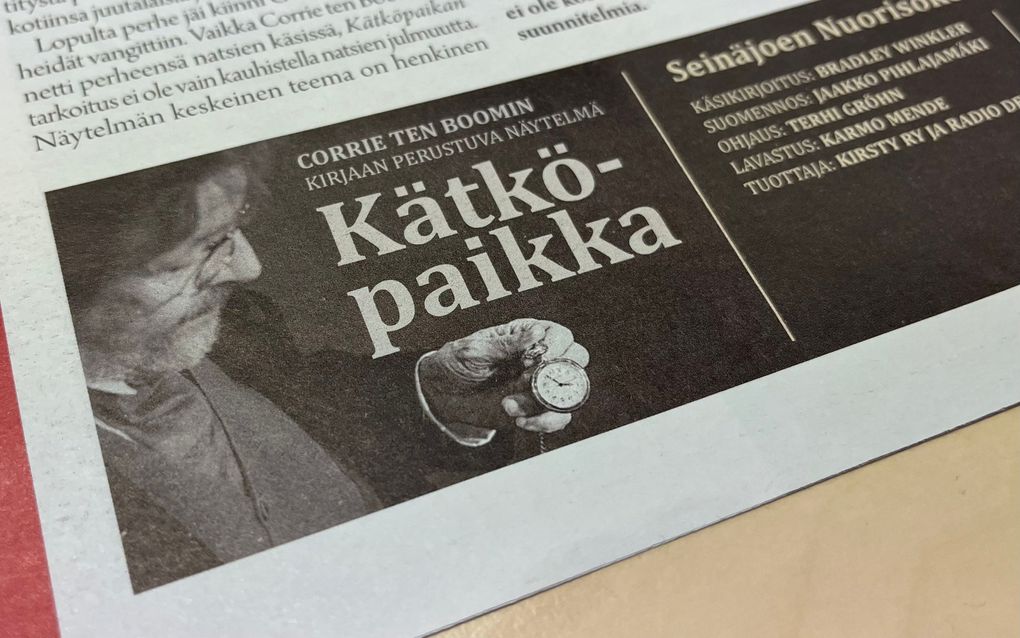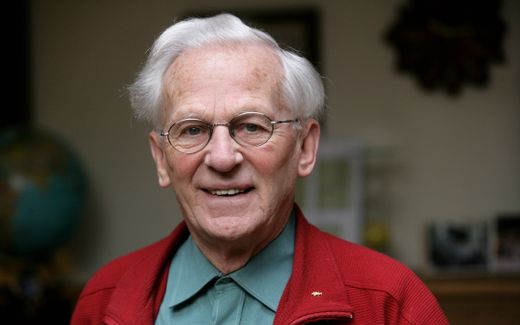Evert’s column: A Finnish beard for Corrie ten Boom’s father

Advertisement for the Ten Boom play in a Finnish magazine. Photo CNE.news, Evert van Vlastuin
Christian Life
Jaakko casually crossed my path last week while I was on the road in Finland’s Biblebelt. As a reporter, I had arranged with a pastor there. He was waiting for me at the church entrance with two others. One of them was Jaakko.
Inside, a pianist and violinist were practising the famous soundtrack from the film Schindler’s List in the church hall.
As I walked in, the Israeli flag on the podium caught my eye. “It’s always been there,” Jaakko assured me; not just after October 7th. That was not the case with the Holocaust exhibition along the wall, which featured Anne Frank prominently. Perhaps not surprising in Finland’s Biblebelt, but I was clearly in a Jew-loving setting here.
I pulled out my camera to make a portrait of Jaakko, and told him I would focus on his full beard. It was still new, he said. “I play father Casper in a show about Corrie ten Boom.”
Sure, like Anne Frank, Ten Boom is known worldwide. But someone in the countryside growing his beard to look like old Casper took me by surprise.
Of course, I understand that Ten Boom is not unheard of in Finland. John and Elizabeth Sherrill’s book “The Hiding Place” was printed in over 40 languages after publication in 1971. It is very clever how the Sherrill couple has turned Corrie’s history into a readable story. With success: 50 million books have been sold.
The Sherrills made another Dutchman famous before. In 1967, they published “God’s Smuggler” about Anne van der Bijl. Last summer, Christianity Today wrote on the death of Elizabeth Sherrill that 10 million copies of this book had been sold, in 35 languages. The Dutch edition was only published this year, shortly after Van der Bijl’s death.
Both books use the I-form. This gives the impression that Ten Boom and Van der Bijl are the authors themselves. You often read that it is an autobiography, which is not true.
I don’t know whether this genre has a name. But I call it the “Christian hero story”. You meet people at the peak of faith here. The story is all written with a velvet pen. You would have loved to kneel with the main character yourself – many prayers are answered before you can even turn the page. I loved reading “The Hiding Place” to our children.
It also remains wonderfully vague which church alignment these people belong to. So, Christians from all directions can identify with them. Their strength is not in doctrine but in their love.
Is this style typical American? In the Netherlands, we also know the “life novel” about resistance fighter Johannes Post (by Anne de Vries) and Prime Minister Hendrik Colijn (by Rudolf van Reest). Of course, everyone senses that these stories have been moulded.
From America, we received Sergei Kourdakov’s “Forgive Me, Natasha” in 1973 (also published under the title “The Persecutor”). It tells (also in the I form) how a communist became a Christian – and remained a tough guy. Also, this title is presented as an autobiography. But gradually, that book lost credibility because of factual problems.
Most of the people involved in those books are no longer alive. So maybe it would be good if real historians wrote a good biography on at least Corrie ten Boom and Anne van der Bijl. Meanwhile, I grant Jaakko his full beard wholeheartedly.
Related Articles








